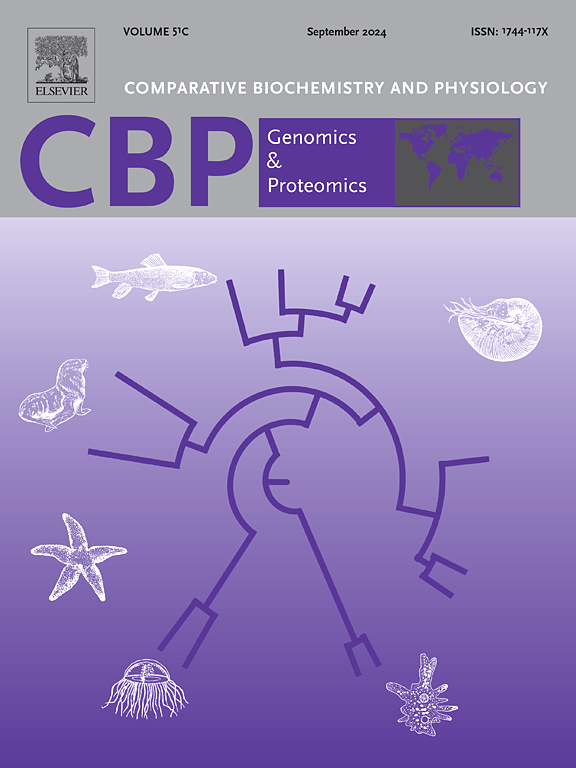农业遗产稻田鲤鱼对稻田主要环境因子的分子响应
IF 2.2
2区 生物学
Q4 BIOCHEMISTRY & MOLECULAR BIOLOGY
Comparative Biochemistry and Physiology D-Genomics & Proteomics
Pub Date : 2024-12-23
DOI:10.1016/j.cbd.2024.101410
引用次数: 0
摘要
作为全球重要农业文化遗产系统(GIAHS)的核心组成部分,青田水田鲤鱼(Cyprinus carpio, f -carp)已经在水田环境中驯化了1200多年。这个物种已经成功地适应了水田的浅水环境。为了揭示这种适应机制,我们在两种温度条件下(28°C和38°C)对PF-carp的肝胰脏进行了转录组测序,同时分析了同一组织在缺氧条件下的RNA-seq数据。通过高温转录组数据分析,鉴定出3154个差异表达基因(DEGs)。KEGG分析表明,deg涉及多种途径,包括内质网蛋白加工、昼夜节律和HIF-1信号通路。值得注意的是,在内质网的蛋白质加工中,HSP70、HSP90、HSP40、CNX、CRT和Bip等关键基因显著富集。通过对缺氧条件下RNA-seq数据的同步分析,我们发现PF-carp通过多种途径调节其代谢,并产生几乎相反的代谢调节以适应高温和缺氧环境。在HIF-1信号通路中观察到的相反的激活状态特别有趣。综上所述,sf -鲤鱼似乎依赖于内质网的蛋白质加工来维持高温下的细胞稳态。HIF-1信号通路可能在pf -鲤适应水田的过程中发挥了关键作用。本研究对水田驯化鱼类的适应机制提供了有价值的见解。本文章由计算机程序翻译,如有差异,请以英文原文为准。

Molecular responses of paddy field carp (Cyprinus carpio) in the agricultural heritage to major environmental factors in paddy fields
As a core element of the Globally Important Agricultural Heritage System (GIAHS), the Qingtian paddy field carp (Cyprinus carpio, PF-carp) has been domesticated for over 1200 years in paddy field environments. This species has successfully adapted to shallow-water conditions in paddy fields. To reveal the adaptation mechanism, we conducted transcriptome sequencing on the hepatopancreas of PF-carp under two temperature conditions (28 °C and 38 °C) and concurrently analysed RNA-seq data from hypoxic conditions in the same tissue. By analysing high-temperature transcriptome data, 3154 differentially expressed genes (DEGs) were identified. KEGG analysis indicated that DEGs involved various pathways, including protein processing in endoplasmic reticulum, circadian rhythm, and HIF-1 signaling pathway. Notably, protein processing in endoplasmic reticulum was significantly enriched with key genes such as HSP70, HSP90, HSP40, CNX, CRT, and Bip. Through concurrent analysis of RNA-seq data from hypoxic conditions, we found that PF-carp regulate their metabolism through multiple pathways and produce almost opposite metabolic regulation to adapt to high temperature and hypoxic environments. The opposite activation state observed in the HIF-1 signaling pathway is particularly intriguing. In conclusion, PF-carp appear to rely on protein processing in endoplasmic reticulum to maintain cell homeostasis at high temperatures. The HIF-1 signaling pathway may emerged as a key player in adapting PF-carps to paddy fields. This study provides valuable insights into the adaptive mechanisms of domesticated fish in paddy fields.
求助全文
通过发布文献求助,成功后即可免费获取论文全文。
去求助
来源期刊
CiteScore
5.10
自引率
3.30%
发文量
69
审稿时长
33 days
期刊介绍:
Comparative Biochemistry & Physiology (CBP) publishes papers in comparative, environmental and evolutionary physiology.
Part D: Genomics and Proteomics (CBPD), focuses on “omics” approaches to physiology, including comparative and functional genomics, metagenomics, transcriptomics, proteomics, metabolomics, and lipidomics. Most studies employ “omics” and/or system biology to test specific hypotheses about molecular and biochemical mechanisms underlying physiological responses to the environment. We encourage papers that address fundamental questions in comparative physiology and biochemistry rather than studies with a focus that is purely technical, methodological or descriptive in nature.

 求助内容:
求助内容: 应助结果提醒方式:
应助结果提醒方式:


